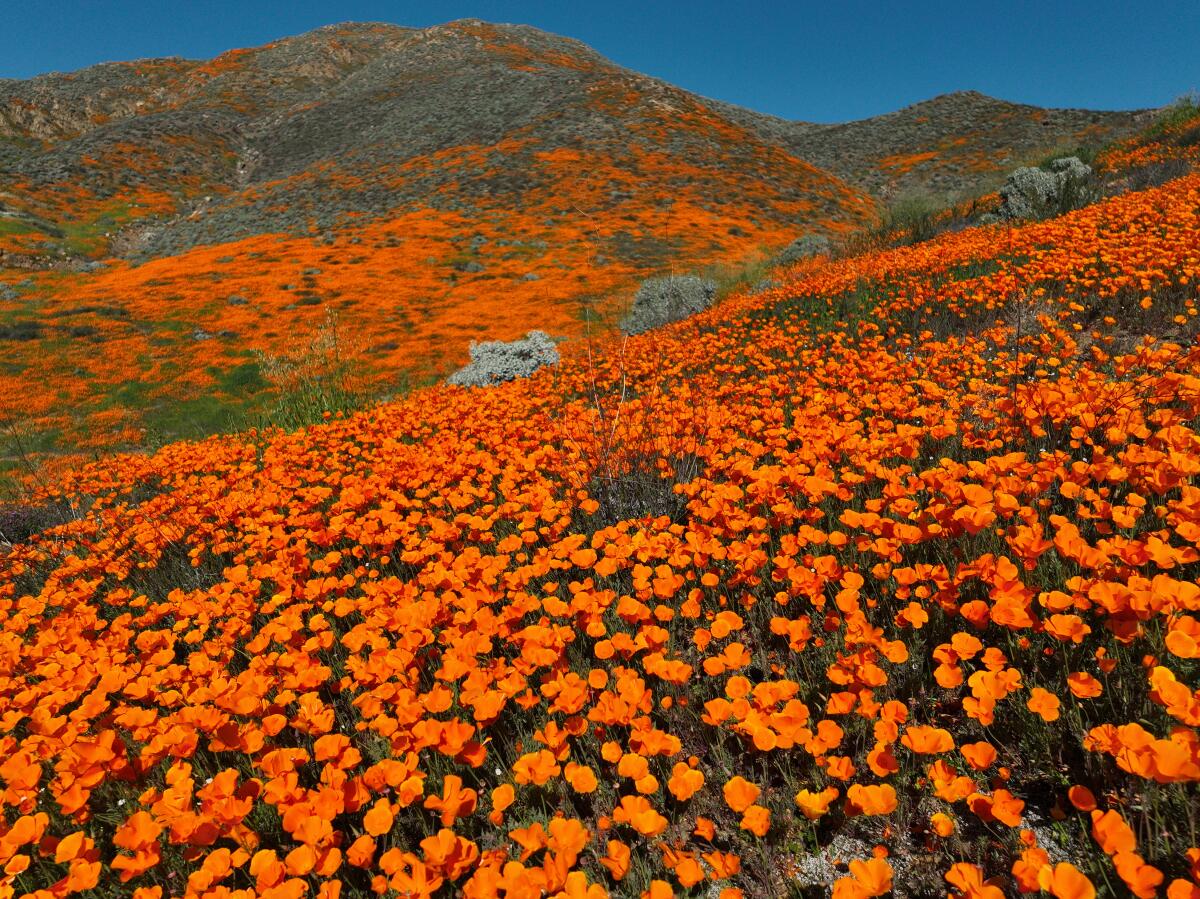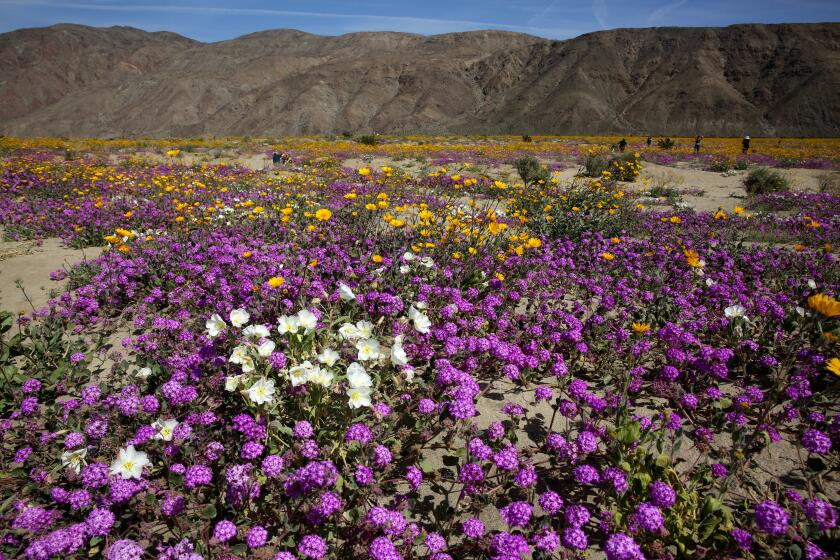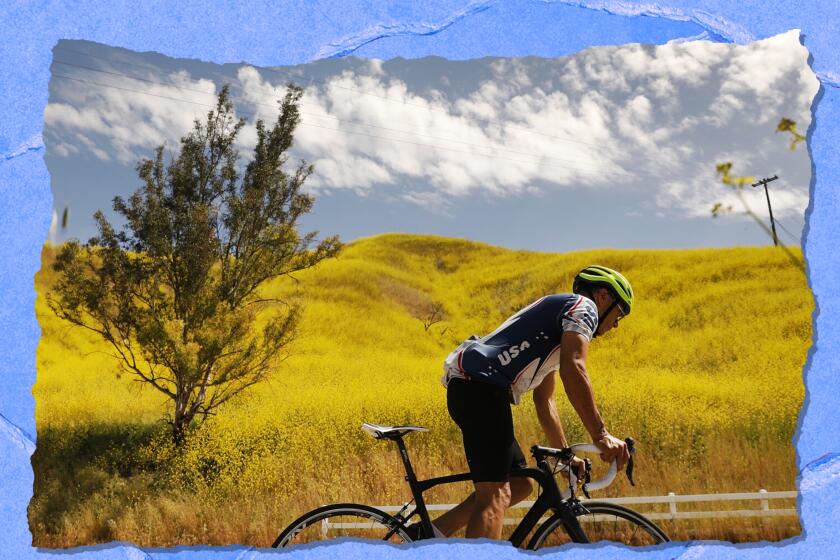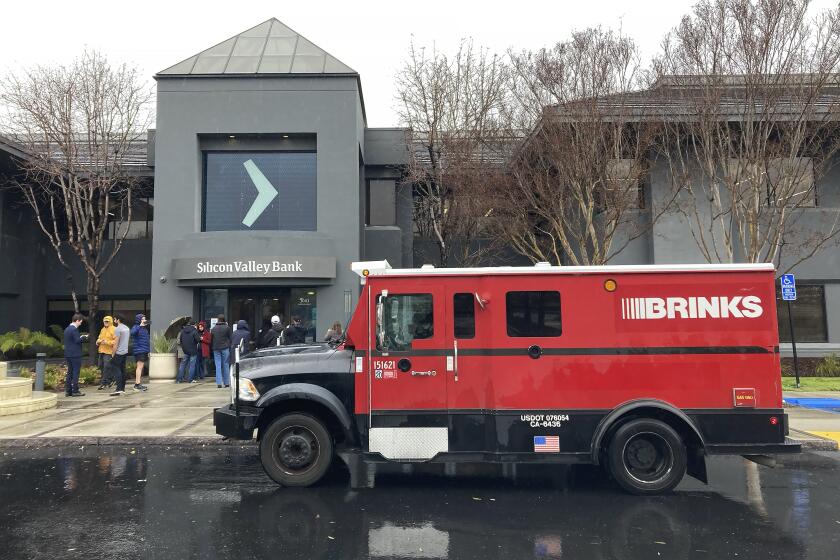Lila Seidman is a reporter focused on California wildlife and the outdoors for the Los Angeles Times. Since joining The Times in 2020, she has investigated mental health policy and jumped on breaking news. A native Angeleno, Seidman holds a bachelor’s degree from Reed College and a master’s degree from Pepperdine University.
1
Scan the rolling hills of the Antelope Valley California Poppy Reserve and you’ll notice something missing.
Golden poppies.
Even as Instagram-worthy wildflowers bloom across the state, the blazing orange flower has been conspicuously absent from some of its usual haunts — including the reserve in Lancaster and the city of Lake Elsinore.
“This year doesn’t seem like it’s going to be a great year for poppies,” said Callista Turner, an interpreter at the state natural reserve that hugs the western edge of the Mojave Desert. She stood outside of the reserve’s visitor center and motioned to fields lacking orange patches on a video call this week.
It might seem counterintuitive. Storm after storm has doused California, prompting wildflower fanatics earlier this year to cross their fingers for a superbloom. But more rain doesn’t mean more growth for every plant.
Theodore Payne Foundation’s Wild Flower Hotline returns on March 8, but will we have a superbloom in 2024? The early signs are hopeful.
A deluge of water can supercharge invasive grasses and plants, which out-compete native plants that need Goldilocks conditions to thrive. The poppy, in particular, doesn’t seem to be popping off.
Lake Elsinore’s Walker Canyon, about an hour-and-a-half drive southeast from Los Angeles, sprouted in a brilliant superbloom last year, prompting city officials to close the popular destination for fear of a tourist crush. This spring, the mountains are relatively bare. (As a precaution, city officials closed the area this year as well.)

A close-up view of California poppies blooming in early 2023 on the upper slopes of Walker Canyon in Lake Elsinore. This year, Lake Elsinore’s mayor said conditions didn’t favor growth of the vivid orange flower.
(Allen J. Schaben / Los Angeles Times)
“The California poppy is temperamental; it requires certain conditions to bloom,” Lake Elsinore Mayor Steve Manos said recently. “This year, those conditions simply did not manifest themselves here in the city of Lake Elsinore.”
The timing of the rain, a plant’s growth strategy and regional differences affect which plants flourish in a given year, said Joan Dudney, an associate professor of global change ecology at UC Santa Barbara.
Native plants actually tend to do better after several years of drought — once invasive species not adapted to the arid climate die out. That’s why the superbloom of 2017 was so spectacular, Dudney said.
Dudney added that the seeds of some native flowers can stay dormant for a long time and don’t necessarily germinate even in ideal conditions. It’s an adaptation that allows them to survive climate variability. A large proportion of invasive grass seeds produced the previous year germinate no matter what. This time it paid off: a second consecutive rainy year has allowed them to thrive, edging out competitors.
“I expected that we would see a bit of a dampened bloom this year, just because we had so much seed production of the non-native grasses last year,” Dudney said.
But it’s not all doom and no-bloom across the state. Desert areas where native plants have less competition are awash in wildflowers. Sand verbena, desert sunflowers and desert primrose recently dazzled onlookers along Henderson Canyon Road in Borrego Springs, an area famed for wildflowers in San Diego County. However, the peak for those blooms has passed.
In his road trip report, Times photographer Raul Roa describes the moment he noticed the holy grail of Anza Borrego wildlife.
The intensely alkaline soil of the Carrizo Plain National Monument, a remote grassland east of San Luis Obispo, also deters invasives from prospering, according to Dudney. Blooms there have started to peak in lower elevations, and Dudney said they’re looking good — but so far not quite as robust as last year.
Some are still holding out hope for a late-season turnaround. Late-arriving rains and cold weather that marked this spring can delay or stymie blooms. A warmup coupled with dry skies could bring forth flowers — even poppies.
Turner, of the Antelope Valley poppy reserve, isn’t holding her breath.

A variety of colorful wildflowers blossomed last April in Lancaster’s Antelope Valley California Poppy Reserve.
(Francine Orr / Los Angeles Times)
“It looks like we probably received too much water,” she said. Even more rain is expected this week. Invasive plants like mustard are torn out to keep them at bay, but they’re tenacious.
There aren’t many baby poppies at the protected open space, which Turner said indicates that what you see now is likely what you’ll get for the remainder of the season. (You can peep the fields through a poppy livecam.)
Sometimes there are actually higher concentrations of poppies on private land outside of the reserve, a phenomenon Turner said can result from sheep and cattle grazing. Poppies like disturbed soil created by plodding hooves and nibbling muzzles. Bulbs and other sensitive flowers don’t do well in that soil.
One of the easiest ways to learn about California native plants is volunteering to get your hands dirty. Here are some opportunities around Los Angeles, Orange and Santa Barbara counties.
Pinning down the peak of the blooms is tricky — it could be happening now or in a week or two, she said. Predictions are based on data from decades ago, but climate change is disrupting reliable patterns. There are now bigger swings between intense hot, dry conditions and cold, wet ones.
While it might not be the year of the poppy, Turner said there are plenty of other flowers worthy of marveling at. Stretches of the reserve are covered in tiny yellow flowers called goldfields. Zooming in on certain areas during the video call with her brought into focus sunshine-colored patches of the flowers on the fields and hillsides. A lone splotch of orange poppies was also visible.
Iridescent cream cups, “always a fan favorite,” sprang up just last week. There are lovely scented popcorn flowers, as well as grape soda lupines that bloom at Tehachapi Point every year.
Also, the California poppy is just one of several types of poppy in the state. There’s also desert poppies and tufted poppies, Turner said.
“It’s a beautiful season for wildflowers. I would just not get hyper-fixated on poppies,” she said. “Take this year to find another wildflower, and go enjoy that one.”
Want to peep wildflowers in Southern California? Do your research and plan ahead to avoid disappointment.
- Peruse California State Parks’ flower bloom updates. The free online resource summarizes the wildflower situation at Anza-Borrego Desert State Park, Red Rock Canyon State Park, Chino Hills State Park and more.
- Call Theodore Payne Foundation’s Wild Flower Hotline, which updates every Friday into June. The number is (818) 768-1802, Ext. 7.
- View the Antelope Valley California Poppy Reserve live cam to get a sense of what you might see.
- Check the weather. Storms can dampen a trip. This week, winds of more than 30 mph were expected at the Antelope Valley poppy reserve — not ideal flower-gazing conditions.
- Don’t pick or trample the flowers. Not even for a cool Instagram photo.
Blooming everywhere, this plant has changed SoCal’s landscapes for the worse.









